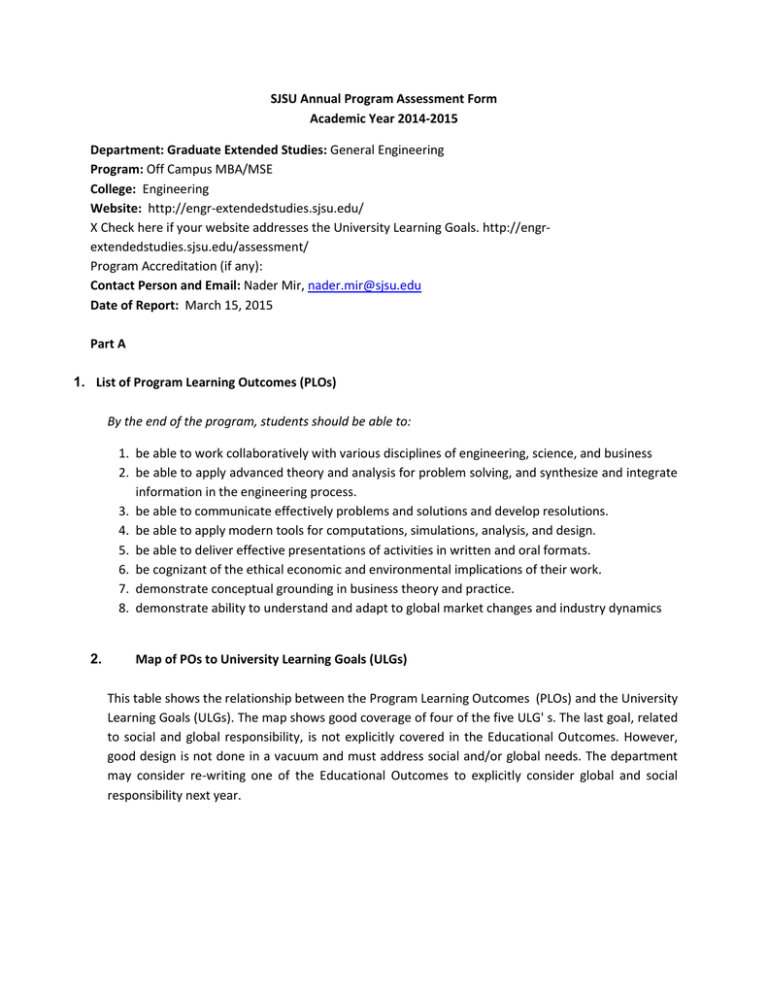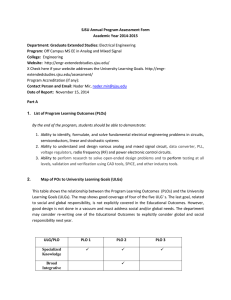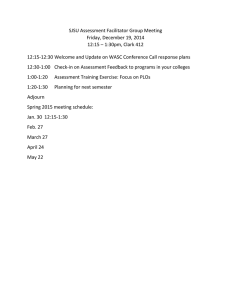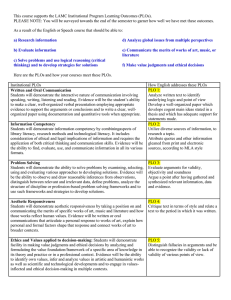SJSU Annual Program Assessment Form Academic Year 2014-2015 Department: Graduate Extended Studies: Program:
advertisement

SJSU Annual Program Assessment Form Academic Year 2014-2015 Department: Graduate Extended Studies: General Engineering Program: Off Campus MBA/MSE College: Engineering Website: http://engr-extendedstudies.sjsu.edu/ X Check here if your website addresses the University Learning Goals. http://engrextendedstudies.sjsu.edu/assessment/ Program Accreditation (if any): Contact Person and Email: Nader Mir, nader.mir@sjsu.edu Date of Report: March 15, 2015 Part A 1. List of Program Learning Outcomes (PLOs) By the end of the program, students should be able to: 1. be able to work collaboratively with various disciplines of engineering, science, and business 2. be able to apply advanced theory and analysis for problem solving, and synthesize and integrate information in the engineering process. 3. be able to communicate effectively problems and solutions and develop resolutions. 4. be able to apply modern tools for computations, simulations, analysis, and design. 5. be able to deliver effective presentations of activities in written and oral formats. 6. be cognizant of the ethical economic and environmental implications of their work. 7. demonstrate conceptual grounding in business theory and practice. 8. demonstrate ability to understand and adapt to global market changes and industry dynamics 2. Map of POs to University Learning Goals (ULGs) This table shows the relationship between the Program Learning Outcomes (PLOs) and the University Learning Goals (ULGs). The map shows good coverage of four of the five ULG' s. The last goal, related to social and global responsibility, is not explicitly covered in the Educational Outcomes. However, good design is not done in a vacuum and must address social and/or global needs. The department may consider re-writing one of the Educational Outcomes to explicitly consider global and social responsibility next year. ULG 3. PLO 1 Specialized Knowledge Broad Integrative Knowledge Intellectual Skills Applied Knowledge Social/Global Responsibilities PLO 2 PLO 3 PLO 4 PLO 5 PLO 6 PLO 7 PLO 8 Alignment – Matrix of PLOs to Courses The following table provides a map of Program Learning Outcomes (PLOs) to the program’s courses. Students also take many electives. For culminating experience, students take MS project (EE 295A/B). PLOs Courses ENGR201 ENGR202 ENGR203 X X PLO1 PLO2 4. ISE230 ISE241 X X X X X ENGR 295A/B X X PLO3 PLO4 ENGR297 X X X X X X Planning – Assessment Schedule Assessment data for each learning outcomes will be acquired every semester and assessed each spring. Program improvements will be implemented August 2015. The assessments are done via EE295A/B since those project courses cover all the learning outcomes. 5. Student Experience The MBA/MSE PLOs are included on program website. Students have some knowledge of outcomes, but they are not included on most syllabi, and discussions are occasional, largely limited to the MS project/thesis courses. Feedback from alumni was incorporated into the development of the outcomes but not current students. Part B <The following items 6-9 will be provided by the IEA office by March 1 every year. The departments are welcome to obtain the data on their own, and/or to report other relevant data for their particular programs if deemed important.> 6. Graduation Rates for Total, Non URM and URM students (per program and degree) <These numbers can be obtained for your program from the IEA website at http://www.iea.sjsu.edu/ under Retention/Graduation. URM stands for Under-Represented Minorities. In some cases, the number of students who choose to report their ethnicity is too small to compute a reliable number, so please check if this is the case before interpreting. The university targets for first-time freshmen 6-yr graduation rates set by the Chancellor’s Office are 51.6%, 47.8%, and 53.2%, for total, URM and NonURM populations, by 2015-2016. The university targets for transfer and graduate students are not specifically published, but generally improvement is expected here too. > N/A 7. Headcounts of program majors and new students (per program and degree) <The headcount of majors in your program can be found at the IEA website at http://www.iea.sjsu.edu/Assessment/ProgRev/default.cfm by major and concentration under your program name. The number of students entering your program can be found under Applied, Admitted, Enrolled on the same page. A robust and/or increasing enrollment provides evidence of demand for your program. > N/A 8. SFR and average section size (per program) <The student-to-faculty ratio (SFR) and the average headcount per section can be found at the IEA website at http://www.iea.sjsu.edu/Courses/default.cfm#Prefix under your department name. SFR and average section sizes provide some measure of cost-effectiveness and faculty load. The values can be compared to the college and/or university averages, or a comparable program at another university, if applicable. Any SFR ratios or average section sizes that are either much bigger or smaller than average should be explained and or addressed.> N/A 9. Percentage of tenured/tenure-track instructional faculty (per department) <This percentage can be calculated with information on the IEA website at http://www.iea.sjsu.edu/Faculty/default.cfm#Dept under your department name. Under Instructional Faculty - Full Time Equivalent Faculty (FTES) - by Tenure Status, the FTEF in each category is listed for each semester. Take the sum of tenured and probationary FTEF, and divide by total FTEF. In 2012, SJSU’s ratio was 53.1%, and we rank 20/23 of all of the CSUs. The highest ratios in the CSU system are 70.6%.> N/A Part C 10. Closing the Loop/Recommended Actions The following actions have been implemented before, and they are still active to pursue: a) ISE230. Instructor will provide additional material about the relevance and importance of understanding the theory behind algorithms. b) ENGR201. MATLAB software needs to be updated through college to assess CLO 4. More projects are desired by students. 11. Assessment Data The assessment data were collected in the form of course learning objectives (CLOs) at the end of each course, course assessment journals (CAJs) at the end of each course, and oral interview with selected students time-to-time. For assessment of achievement of education outcomes, our attention will be made more on the MS projects and theses through. The following two table provides the description of program education objectives (PEOs) and their relationship to PLOs: Program Educational Objectives List PEOs PEO 1 been successfully engaged in multidisciplinary practices in the chosen discipline. PEO 2 demonstrated personal and professional leadership in the work and community environment. PEO 3 demonstrated effective communication in an engineering environment. PEO 4 employed formal and informal learning opportunities to maintain and enhance technical, professional, and personal growth. Within five years of graduating from this program, engineers should have: PEOs Program Outcomes PLOs PLO1 PLO2 PEO 1 X X PEO 2 X X PEO 3 X PEO 4 X PLO3 X PLO4 X X X PLO5 PLO6 X X PLO8 X X X X X PLO7 X X X X 12. Analysis <Please discuss data and evaluate achievement of PLOs and/or progress on recommended actions. Please consider the composition of your students in your interpretation, if applicable. > Data will be assessed in January of 2016 when the final MS projects are done. . 13. Proposed changes and goals (if any) Directly from instructors: No major modification or improvement in ENGR203 is needed. The instructor of ENGR203 believes this was a positive experience for this new cohort. He received many positive comments related to the expertise I demonstrated and the energy and style with which he conducted the class. He feels he was successful at both establishing a solid engineering management basis for this cohort, establishing a framework that provided for tie-in of future class subject areas, and in and setting a positive tone for the class experience in general. Overall performance of the class was very good to excellent in all areas, with some potential areas for improvement in approach, for future conduct of this class, noted above. No major modification or improvement in ENGR202 is needed. The instructor of ENGR202 thinks the class was a delight and a challenge to teach. The dynamics of this class was excellent: with much classroom discussion and “challenges” to the “typical” Systems Engineering discipline and how is it implemented in “small and/or start-up” companies. This Lecturer believes in the end that students all grasped the concepts of Systems Engineering, understood the tools (with exceptions noted from the CLO Comments) and how to implement them, and recognized the benefit of viewing the product design/product life cycle as a system in its entirety. At the end of the class, many of the students indicated that the concepts, ideas, and tools had already helped them in their daily work at their company. Students to work in groups, and for the most part they have, however I’ve found that allowing them to self-organize into groups tends to result in the best students working together and the worst students stuck with each other, which only increases this gap. 14. Assessment Data <Please briefly describe the data collected for this report (i.e. how, when and why). The data can address achievement of POs and/or recommended actions. The instruments used and actual data can be attached as appendices as appropriate. > The assessment data were collected in the form of course learning objectives (CLOs) at the end of each course, course assessment journals (CAJs) at the end of each course, and oral interview with selected students time-to-time. 15. Analysis <Please discuss data and evaluate achievement of POs and/or progress on recommended actions. Please consider the composition of your students in your interpretation, if applicable. > In ENGR203, all CLOs 1, through 8 contributed to this PO. The direct measurement: the acceptable students’ performance criteria are collectively set at score 80%. All CLOs were achieved by an overall average of 93.10% of the students as assessed by exam and homework questions. As a result, the performance criteria were achieved. The indirect measurement: for Part 1 (importance of course topic), the acceptable performance is set at “B” or 3.75/5.00 and acceptable percentage of students who pass the above score is also set at 80%. Overall, the average class score given by students is: 4.60/5.00, and 100% of all students met the acceptable performance. For Part 2 (portion learned and achieved), the grand average class score by students is: 4.72/5.00, and 100% of all students met the acceptable performance. In ENGR202, all CLOs 1, through 5 contributed to this PO. The direct measurement: the acceptable students’ performance criteria are collectively set at score 70%. All CLOs were achieved by an overall average of 83.50% of the students as assessed by exam and homework questions. As a result, the performance criteria were achieved. The indirect measurement: for Part 1 (importance of course topic), the acceptable performance is set at “B” or 3.75/5.00 and acceptable percentage of students who pass the above score is also set at 70%. Overall, the average class score given by students is: 4.58/5.00, and 100.0% of all students met the acceptable performance. For Part 2 (portion learned and achieved), the grand average class score by students is: 4.30/5.00, and 100% of all students met the acceptable performance. 16. Proposed changes and goals (if any) <Please list proposed changes and goals for the next academic year and the future, and identify areas to be assessed. >


